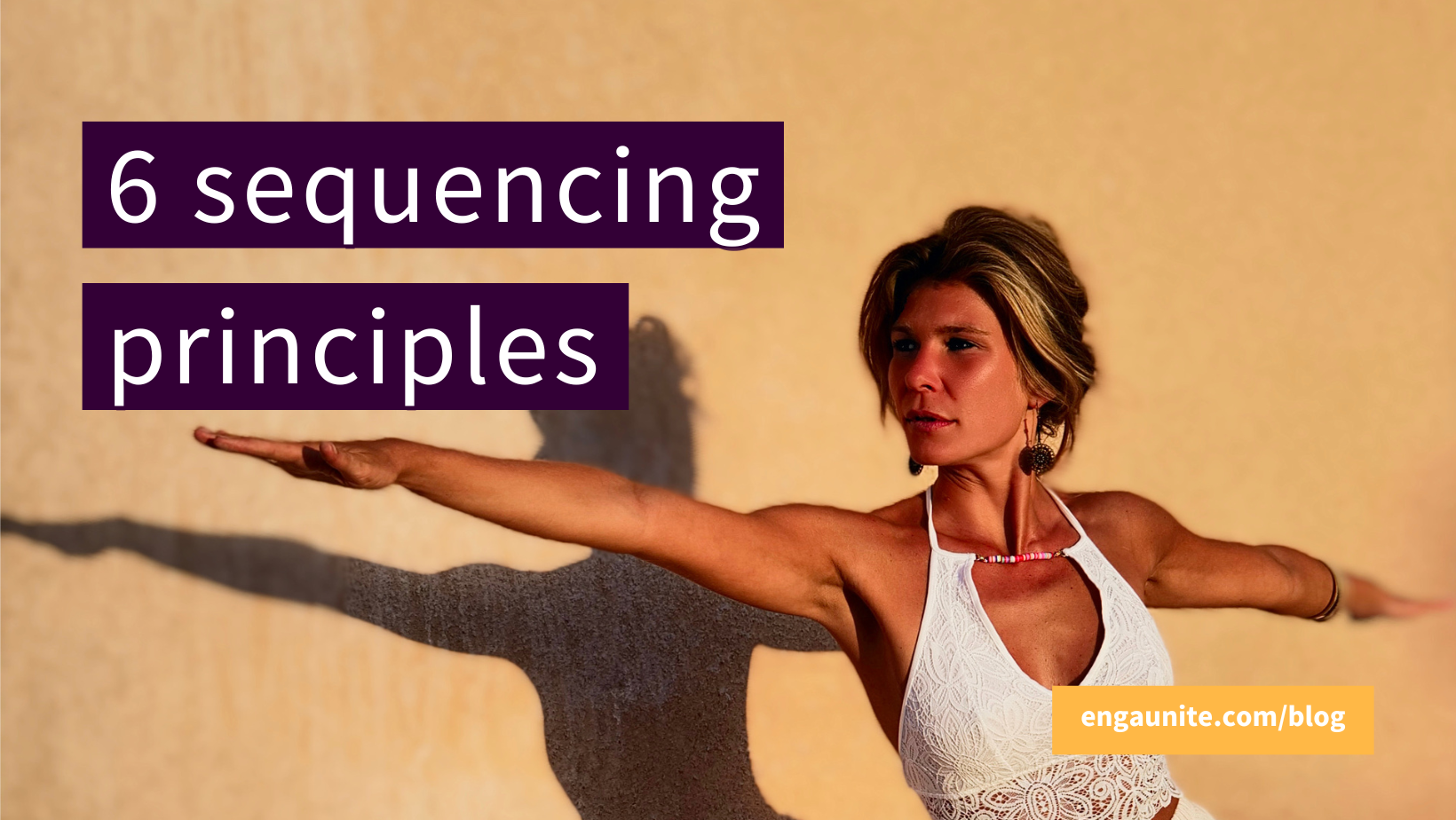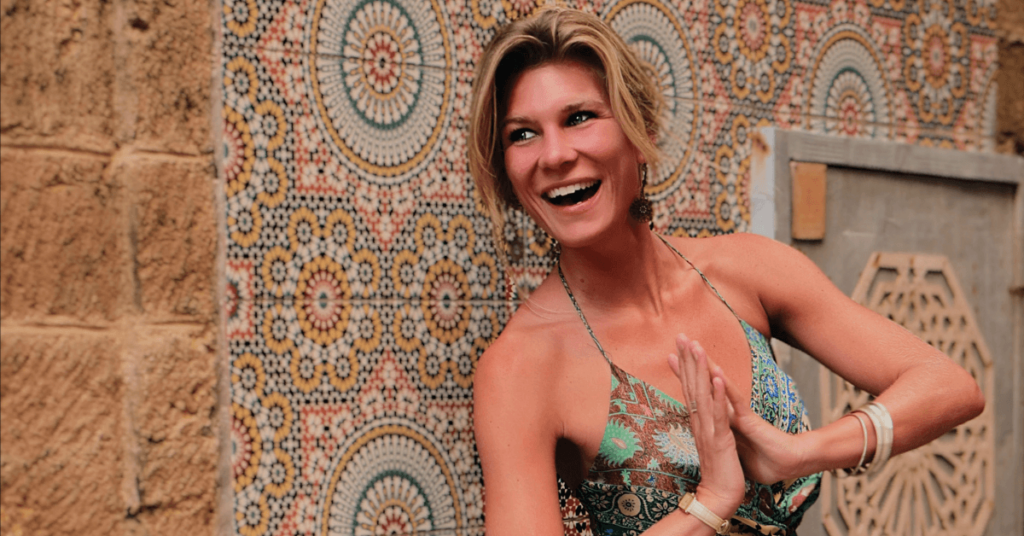As a teacher, you take on the responsibility of being a role model, guide or mentor to your students. The primary steps to grow in your role as a teacher are the development of your language and communication. But, the way you guide your students goes further than communication alone. So in this blog, let’s have a look at 6 sequencing principles to write, design and theme well rounded practices.
How confident do you feel about creating a sequence?
Before we started the previous TYIE Journey, I asked our students this question too and this is what they said:
‘My sequences lack imagination, I wish they were more inspiring.’
‘There’s only one sequence I know well, so I always teach the same.’
‘I wish I knew how to theme my classes so I could teach more than just the asanas.’
‘I want to teach using more spiritual elements, but I feel stuck designing a sequence.’
Is any of these thoughts true for you too? You’re not alone!
I admit, when I finished YTT, this is exactly what I though too. During my YTT I received so much information that I knew a little bit about everything, but too little to feel ready to teach.
I felt extremely inadequate and didn’t think it was fair to call myself a yoga teacher.
Apart from not knowing the right vocabulary, I felt my sequences lacked structure. I improvised a sequence but actually didn’t know what I was doing. This made me lack confidence in my teaching skills as a whole.
Most yoga teachers feel this way after finishing YTT. Either they’re oversaturated and don’t feel ready to use their new knowledge. Or they feel inadequate to even teach the simplest things. To keep my promise of helping you teach with confidence, I decided courses need more. To me that means practice opportunities to improve your sequencing techniques But also gain the skill to build a transformative class experience.
On the Journey we dive deep into the art of building effective sequences. In the 5th module, I teach you how to build arc structured sequences that you can use again without feeling repetitive. This way you’ll always feel prepared and have options to choose from and adapt your classes to your students’ needs. You’ll learn how to theme your classes and add a personal touch. To feel confident about the way you shape your classes.
Sequencing principles can differ depending on the style of yoga
To help you make progress today, I’ll share some of the elements you should consider for building an all-inclusive sequence. Take pen and paper! Because this way you’ll be able to revise your existing sequences or start creating new ones and feel confident and organised.
First of all, depending on the type of yoga you teach, there can be a different approach in the way you structure your sequences. For example: a Yin sequence doesn’t have the same warm-up or heating elements as dynamic yoga classes. There we focus on stretching and compressing deeper tissues to move more freely, which makes that the positions are held for a longer duration of time and your sequence includes less asanas. If you teach Ashtanga, Power or Bikram, you use ‘set sequences’ – these sequences are already designed for you and always include the same order of asanas. Styles like Hatha and Vinyasa offer more flexibility in the way you structure your sequences. Here you can experiment with asanas that you love and add themes or intentions you want to work with.
The elements we look at today are useful for ALL types of ‘creative’ sequences, in other words, the sequences YOU create from scratch!
To create a well-rounded yoga sequence that targets all muscle groups, leaves students feeling balanced, and balances strength training, flexibility, mobility, and relaxation, consider incorporating the following elements:
6 sequencing principles
Sequencing Principle 1: Directions of movement
A teacher I love, Jeremy Devens, once said …. as a yoga teacher you’re a GPS with a heart. You take your students from point A to B, with clear and effective directions, but still speaking compositionally.
If you want to be your student’s GPS you need an understanding of the directions of movement. It’s like having a compass for your yoga sequences. It involves knowing how the body moves in various positions: forward bends, backward bends, twists, and side bends. Or as you may remember from YTT flexion, extension, rotation, and lateral movements. Having this knowledge enables you to create fluid and balanced transitions between the asanas.
Why it’s important:
- It ensures targeting all muscle groups, leaving your students feel more balanced
- You’re informed on moving more safely preventing strain or injury.
- It allows you to craft sequences that flow seamlessly, providing flow and a harmonious experience.
- You can tailor sequences to address specific needs, whether it’s enhancing flexibility, mobility, strength, or balance.
Sequencing Principle 2: Learn about the effect and benefits of asana (groups)
Every yoga asana has unique effects on the body, mind, and energy. Understanding these effects and benefits empowers you to select positions that align with your class’s goals, intention, or purpose whether it’s relaxation, energising, or grounding, or a practice focussed on strengthening or stretching certain body parts or muscle groups.
Why it’s important:
- You can create purposeful sequences that suit to your students’ individual needs.
- It enhances your ability to guide students towards their desired outcomes or the intention you have for your class
- It adds depth to your teaching, making your classes more meaningful and impactful.
Sequencing Principle 3: Choose a peak
Depending on the style of yoga you teach a peak can be more or less intense. In yoga sequencing, a “peak pose” is often the most challenging posture of your sequence. It’s the climax that students work towards throughout the class. The choice of a peak pose should align with the style of yoga you’re teaching. (remember my example of the differences in sequencing I spoke about – yin, vinyasa, hatha, ahtanga, power, bikram etc.
Why it’s important:
- It gives your class a clear focus and purpose.
- Students feel a sense of achievement when they reach the peak pose.
- It provides structure and direction to your sequences.
Sequencing Principle 4: Add a theme or intention
Themes or intentions infuse depth and meaning into your classes. Themes can be around yogic concepts, your studies of the yamas and niyamas, yoga sutra or Bhagavad gita, or other conscious concepts like gratitude, self-compassion, or balance. Setting an intention guides the spiritual, emotional and/or mental aspects of your practice.
Why it’s important:
- It creates a more holistic yoga experience, addressing the mind and heart, not just the body.
- Students connect with the practice on a deeper level, finding it more fulfilling.
- Students get the chance to develop self-awareness on the different planes of their existiance, beyond movement and physicality.
- Themes or intentions make your classes unique and memorable.
Sequencing Principle 5: Follow an arc
The arc of a sequence is ‘a journey’ – its flow from start to finish. It should feel natural, guiding students through warm-up, peak, and cool-down phases. Think of it as a story you’re telling through movement. Or as Marc Stephens describes, a trek through the wilderness taking your students up and down a mountain.
Why it’s important:
- It ensures a gradual and safe progression through the practice.
- Students remain engaged as they journey through different phases.
- The arc creates a sense of completeness, leaving students balanced and satisfied.
Sequencing Principle 6: Make it your own
Your authentic voice and style are your superpowers as a yoga teacher. While you take other teachers as an example and learn from various sources, it’s crucial to develop your personal expression and let your personality and unique approach shine through your sequences. Your personal touch makes your classes memorable and distinct. And, what your students want to come back for time and time again!
Why it’s important:
- It sets you apart from other teachers, making it more personal and causing your students choose you over other teachers
- Students connect with your authenticity and teaching style, it’s a ay to build storng and profound s-t relationships
- It allows you to share your passion and love for yoga with your students; you can choose your own intentions, phrases, metaphors, music playlists and much more and thereby teach what you know and share what you love the most
Incorporating these elements into your sequencing skills not only enhances your teaching but also brings depth and richness to your classes. It enables you to guide students on a transformative journey, that fosters confidence and connection on the yoga mat.
These principles will help you become well-equipped to create classes that leave a lasting impact.
Optimise your sequencing skills today!
My mission is crystal clear, I’m here to help you teach with total confidence in English. But teaching with total confidence goes further than learning the right words, cues or effective communication.
Some of the teachers that join our programmes are surprised with what they learn. They expect an English course, but in reality it’s much more than that!
The Teach Yoga In English Journey I’ve designed isn’t focussed on English alone; it’s focussed on developing your authenticity and feeling 100% capable of leading effective classes. Therefore, you’ll also learn to improve your sequences and ability to adjust your classes to your students needs (on the spot). It’s an all round continuing education programme to help you improve your English vocabulary, cueing skills + overall teaching techniques + career development.
If you look for a way to enhance and make your teaching more profound, the Journey provides you with all you need to improve your English vocabulary, cueing skills, overall teaching techniques, and build your international career!
On the programme, you’ll learn and practise using…
🗣️ … the words you need to express yourself appropriately and authentically;
📚 … advanced teaching vocabulary to alter your communication to your students needs;
🚀 … all your knowledge and skills to fully embody them and own your teacher identity;
🧭 … instructional sentences, but also inclusive and creative cues;
🧘♀️ … sequencing techniques, asana blocks to make your classes personal, logical and intuitive;
🌈 … themes and your creativity to add a personal touch and offer a well-rounded practice;
🤗 … the tools that make your classes accessible so that you can welcome students of all backgrounds.
This way, I want you to let go of intimidation and comparison, embrace yourself and seeing other teachers as equals.
>>> Check out the Teach Yoga In English Journey
And don’t forget to take the Quiz: What’s Your Style of Teaching Voice?


